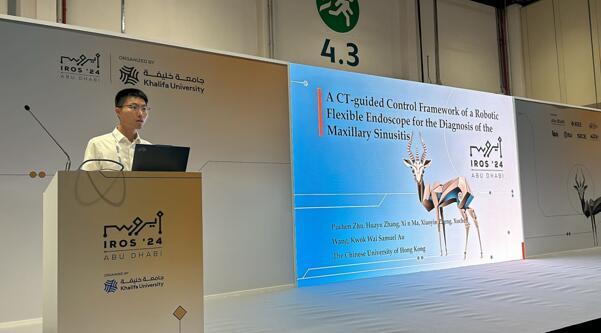
 0 Comment(s)
0 Comment(s) Print
Print E-mail China.org.cn, October 28, 2024
E-mail China.org.cn, October 28, 2024
The 2024 IEEE/RSJ International Conference on Intelligent Robots and Systems (IROS 2024) concluded on October 18 in Abu Dhabi, UAE, bringing together leading researchers from around the world to showcase cutting-edge advancements in robotics and intelligent systems.
Among the standout contributions was a pioneering study from The Chinese University of Hong Kong and Hong Kong Multiscale Medical Robotics Center, in collaboration with researchers from Xmotors.ai, on a CT-guided robotic endoscope for minimally invasive surgery in maxillary sinusitis. Selected for an oral presentation, this study was recognized for its remarkable innovation and clear advantages over traditional surgical methods. The approach shows promising potential to reduce patient discomfort, simplify surgical procedures, and improve precision.
Flexible Endoscopy and Advanced Vision Technology: Ushering in a New Era of Surgical Precision
Traditional maxillary sinusitis surgeries often require large incisions, leading to considerable patient discomfort and noticeable facial scars. Even with rigid endoscopes, the intricate structure of the nasal cavity presents challenges for accessing deeper areas, while prolonged manual manipulation can lead to surgeon fatigue and heightened risks of errors.
The team, led by Professor Xin Ma from The Chinese University of Hong Kong and Hong Kong Multiscale Medical Robotics Center, in partnership with researchers from Xmotors.ai, offers an innovative solution: a flexible endoscope with CT-guided, computer-vision-based navigation. This flexible endoscope enables a minimally invasive approach, reaching the surgical site with ease and accuracy. By integrating real-time CT imaging and advanced vision technology, the system can automatically guide the endoscope, reducing the need for manual control and minimizing the risk of human error. This approach enhances precision and safety, paving the way for a new era of surgical precision and patient comfort.
Leveraging the Lisa Model for Future-Proof Vision Technology
A key component of this research is the use of advanced computer vision based on the Lisa model, which employs open-vocabulary object segmentation and endpoint detection. This state-of-the-art vision language model (VLM) technology is deployed in medical imaging, bringing unprecedented scalability and adaptability. As surgical tools evolve, users can simply adjust text-based prompts to reposition new instruments without retraining on extensive datasets. This flexibility reduces resource consumption and enhances the versatility of the technology, offering significant efficiency gains for future applications in medical imaging.

Xiaoyin Zheng, the researcher from Xmotors.ai, presenting the CT-guided robotic endoscope study at IROS 2024. [Photo provided to China.org.cn]
Robotics and Vision Technology: Advancing the Future of Healthcare
With rapid advancements in computer vision and robotics, these technologies are increasingly transforming the medical field. From precise surgical procedures to intelligent diagnostic devices, the impact of these innovations on healthcare is profound, improving patient outcomes while enhancing safety and comfort. The collaborative study by The Chinese University of Hong Kong and Xmotors.ai captures this trend, providing a glimpse into a future where robotics and advanced vision technologies play a vital role in medical advancements.
Held from October 14-18, 2024, at ADNEC in Abu Dhabi, IROS 2024 was themed "Robotics for Sustainable Development." One of the world's largest and most significant robotics research conferences, IROS has been a platform for sharing advancements in intelligent robotics since its founding in 1988. This year's event highlighted the role of robotics in achieving global sustainability goals and showcased the contributions of emerging researchers and practitioners through keynote talks, workshops, technical sessions, competitions, and interactive forums.
Go to Forum >>0 Comment(s)